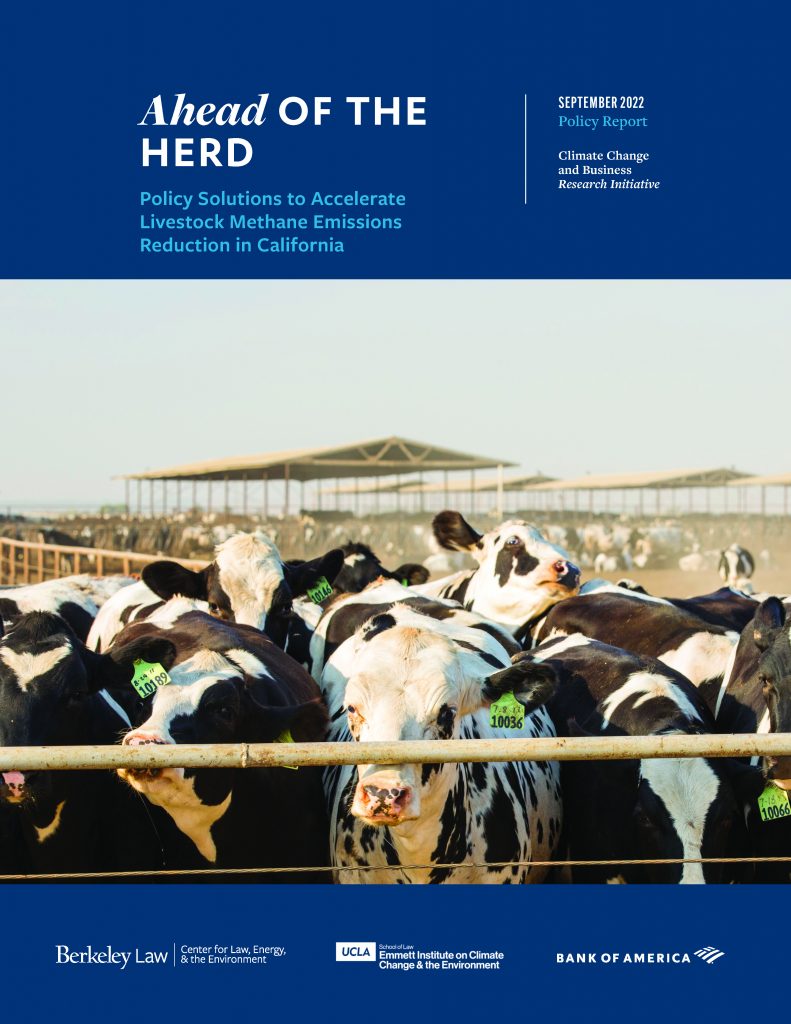Methane is a climate super-pollutant that is 80 times more powerful than carbon dioxide over a 20-year period. Given its potency and short life, experts believe that reducing methane emissions is the highest-yield action that governments and businesses can take to curb near-term warming.
In the US, livestock are responsible for over one third of anthropogenic methane emissions; in California, this number is over 50 percent, largely due to the state’s dairy sector, whose 1.7 million cattle produce nearly 20 percent of all US milk. State leaders have taken first-in-the-nation steps to address livestock emissions, but much work remains to achieve 2030 targets.
Our new report Ahead of the Herd from CLEE and UCLA’s Emmett Institute recommends several actions for state leaders to meet these targets while prioritizing environmental and public health:
- Create an interagency one-stop shop for greenhouse gas, air quality, water quality, and other data reporting and technical assistance
- Update the state’s Low-Carbon Fuel Standard to better assess the full life-cycle impacts and additionality of digester projects, support environmental health protections, and increase certainty for operators
- Accelerate approval of and increase financial support for new enteric emission reduction strategies
Livestock methane emissions stem from two oxygen-free (anaerobic) environments: the gut of animals, which produces enteric emissions in the form of burps; and liquid pools where manure is stored. (Worldwide, enteric emissions represent the majority of livestock methane, but in California the balance is closer to 50-50 due to the high prevalence of liquid manure storage at large-scale dairy operations.)
These two emissions sources call for two distinct sets of emissions reduction strategies. For manure emissions, the strategies include anaerobic dairy digesters that capture methane to generate energy or convert it into offsite fuels; and alternative manure management strategies that introduce oxygen into the waste storage process or filtering the waste through an ecosystem of hungry earthworms. For enteric emissions, the strategies include feed additives, diet modifications, vaccines, and breeding techniques that alter the chemistry of digestion to reduce methane generation.
California has developed a number of programs to reduce these emissions and as a result, according to the California Air Resources Board, has achieved a methane emissions reduction of over 3 million metric tons of CO2 equivalent since 2013. But the state is only on track to achieve about half of the 9 million metric ton reduction needed to achieve the 2030 target.
At the same time, dairy digesters—the leading emissions reduction strategy to date—are highly controversial. Neighboring communities and environmental justice advocates have serious concerns around the air and water quality impacts of large-scale, concentrated dairy operations—impacts that they argue are exacerbated by incentives for digesters. Industry leaders counter that facility concentration is driven by industry-wide economics rather than by digesters, and that digesters reduce certain air quality impacts compared to uncontrolled facilities.
To learn more about this issue and the report, RSVP here for our November 10th webinar, which will discuss the report and promising strategies to reduce livestock methane emissions, featuring:
- California Department of Food and Agriculture Secretary Karen Ross
- Ermias Kebreab of UC Davis
- Albert Straus of Straus Family Creamery
Download the Ahead of the Herd.
This post is co-authored by Ted Lamm.



